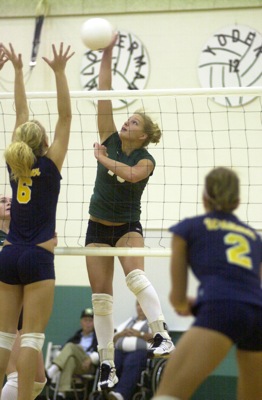Tuesday, September 5th, 2006
Nearly 2,000 residents petition state candidates to improve water quality
By Nancy Allen
The Lake Improvement Association (LIA) last week mailed petitions containing almost 2,000 signatures to candidates for Ohio governor, Ken Blackwell and Ted Strickland, about the plight of Grand Lake.
"Hopefully, we will make our voices heard," said membership chairwoman Gayle Sachs, upon reporting during Saturday's LIA meeting that the petitions had been mailed.
The nonprofit LIA, with a membership of 600, has been lobbying state and federal legislators in recent years for funds to help improve water quality in the 13,500-acre lake and in the 71,862-acre watershed area that drains into it. The group suggests the funds be used to buy land around the lake to build wetlands that filter out excess soil runoff and attached nutrients, shoreline protection measures and dredging.
The LIA has been collecting the signatures for the past several months in an effort to get the water quality problems in the state's largest inland lake noticed. The lake and its watershed has been deemed one of the most degraded in the state based on the results of water quality testing done by the Ohio EPA in 1999.
LIA members agreed that while the lake summit held Aug. 23 at Wright State University-Lake Campus was a good vehicle for discussing the lake's problems and dispelling misinformation, the event lacked a call to action.
The summit involved a moderator asking 13 panel members made up of state, federal and local officials questions about the lake. Members of the almost 200 public members in attendance were able to ask questions of the panel members via index cards that were channeled to the moderator. The event was sponsored by State Rep. Keith Faber, R-Celina and Mercer County commissioners.
"We encourage Faber and commissioners to hold another meeting on how it will be done and who will step up," said LIA member Jeff Vossler.
LIA President Bill Ringo said he felt the summit made it easier to talk about lake issues.
"I think we can agree it's now much easier to discuss the problems with the lake now that the community came together for that meeting," Ringo said.
Under other matters, LIA member Connie Fielding reported the LIA has a new Web site address (lakeimprovement.com) and a redesigned Web site, and that the LIA also has launched a new blog at www.savinggrandlake.com. The blog, short for Web log, is a place where citizens concerned with the lake can post comments.
"In less than a month, the traffic on the blog is already better than the regular Web site," Fielding said.
Under dredging matters, Grand Lake St. Marys State Park Manager Craig Morton reported that the first sediment trap in an unnamed lake tributary at state Route 219 and Club Island Road has been completed and a second trap in Barnes Creek behind the St. Marys Township house is half complete. A sediment trap is an area dug out at the bottom of a creek that catches sediment before it enters a body of water.
Morton said the state will build two more sediment traps in Beaver Creek along county-owned property east of the Lakefield Airport runway and in Big Chickasaw Creek where it crosses state Route 219 east of Behm's Landing yet this fall.
Award for guarding the lake:
Two men who revived annual stump removal on the lake were awarded the LIA's annual Guardian of the Lake award during Saturday's LIA meeting.
Tom Gottschall and Tom Scheib some years ago got with former Grand Lake St. Marys State Park Manager Frank Giannola to revive the stump removal program. The pair use two boats with a rope tied between the boats to drag the lake's bottom for stumps and other obstacles. Attached to the rope are three, 10-pound weights. They then mark the stumps and contact state officials to remove them.
"Tom Scheib is really the moving force behind this," Gottschall said, laughing and explaining how Scheib eventually talked him into helping. "It can get pretty hairy sometimes when you snag something big and the two boats about come together and hit in front, but we about got it down to a science now."
The award is given annually to recognize people, persons, groups or companies that have contributed to the improvement of the lake and its environment.
